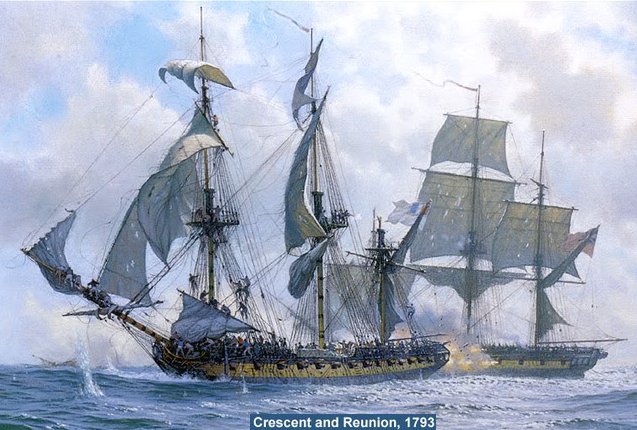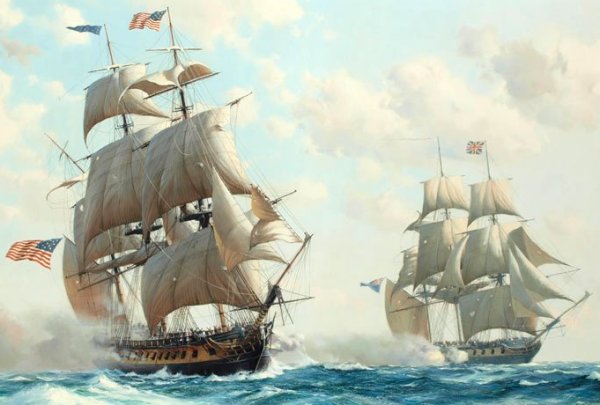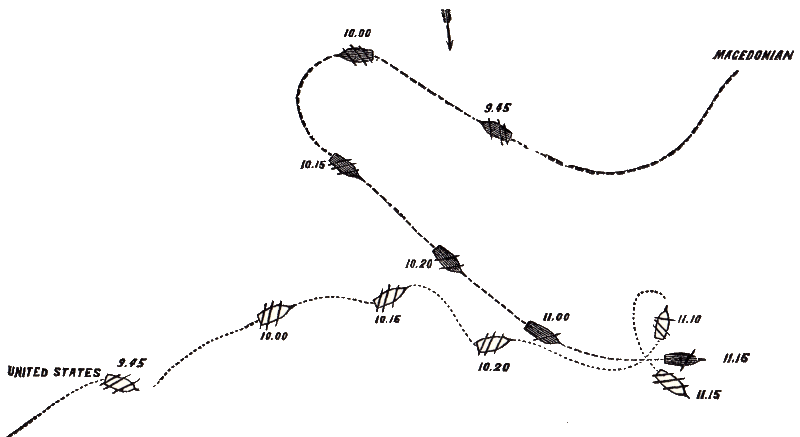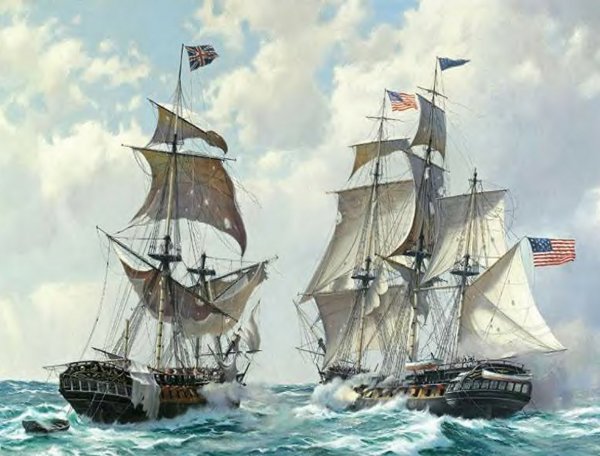









6/10/14
 |
 |
|
|
HMS Macedonian was a Lively Class frigate of 38 guns. The Lively class frigates were a series of sixteen ships built to a 1799 design by Sir William Rule, which served in the Royal Navy during the Napoleonic Wars, and along with the Macedonian, included: Lively, Resistance, Apollo, Hussar, Statira, Horatio, Spartan, Undaunted, Menelaus, Nisus, Crescent, Bacchante, Nymphe, Sirius, and Laurel.
They were considered the most successful British frigate design of the period, much prized by the Navy Board; after the prototype was launched in 1804 (when three more had already been ordered to the same design), a dozen more sister-ships were ordered to her design, although slightly modified (in 1805) to have the gangways between forecastle and quarterdeck more integrated into the upperworks, a step towards the final enclosure of the waist.
Macedonian was built at Woolwich Dockyards, England, in 1809, launched on 2 June 1810, and commissioned in the same month, with Captain Lord William FitzRoy in command. Among the original crew was the 13-year-old Samuel Leech, who later wrote a memoir of his experiences. Macedonian first delivered a company of soldiers to Lisbon, Portugal, and then remained in the area, guarding against the possibility of French naval attack. During this period, FitzRoy made personal profit by falsification of records of ships' stores, for which he was court-martialled in March 1811 and dismissed from the service (he was quietly reinstated in August, presumably due to his aristocratic rank). FitzRoy's replacement, William Waldegrave, was an interim appointment whose command lasted for only a few weeks before he was himself replaced by John Surnam Carden. One of Carden's first actions was to hire a band, a move popular with the crew, but he did not get along with the first lieutenant David Hope. In January 1812, Macedonian was ordered to secretly deliver some bills of exchange to Norfolk, Virginia, and to bring back an equivalent quantity of gold and silver specie, as part of a scheme to keep the Bank of England solvent. During the visit, Carden socialized with the notables of Norfolk, including then-Captain Stephen Decatur, but bungled the mission by inadvertently revealing what was planned, and had to return to Lisbon empty handed. While Macedonian was in Norfolk, Captain Carden dined frequently with Captain Decatur and his wife Susan and the men allegedly bet a beaver hat on the outcome of a battle of their ships. On June 18th, 1812, the United States declared war on Great Britain. In September, Macedonian was ordered to accompany an East Indiaman as far as Madeira, then to cruise in search of prizes as long as his supplies permitted. The frigate left Madeira on 22 October, but only a few days later, on the morning of the 25th, encountered the frigate United States, commanded by none other than his erstwhile dinner host Stephen Decatur. The United States had just declared war on Britain, and both captains were eager to achieve personal glory in a fight.
Unfortunately for Macedonian, United States was one of the big 44-gun frigates, and her broadside was 864 pounds of metal, vs Macedonian's 528 pounds. United States hove round, turning downwind and making HMS Macedonian chase her. Within a few minutes of closing, fire from the United States's 24 pounder cannons brought down all three of Macedonian's masts, and riddled the hull. United States then pulled away temporarily, leaving Carden and Hope time to contemplate their lack of options. Finally, with the United States preparing to rake the British vessel again, Carden struck his colors, making the Macedonian the second Royal Navy vessel of the war to surrender to Americans.
Decatur was careful to preserve Macedonian, sending over a detail to help repair her. After 2 weeks of repair at sea, Decatur then brought his prize into Newport, Rhode Island, on 4 December 1812, causing an immediate national sensation. Constitution had previously beaten HMS Guerriere, but Guerriere had been too badly damaged to save. Macedonian was taken into American service in April 1813 with Captain Jacob Jones in command. Macedonian made one attempt with the United States and sloop Hornet to break the British blockade by way of Hell Gate, New York, 24 May 1813. The squadron was cut off by a strong British squadron commanded by Sir Thomas Hardy, Nelson's flag captain of the HMS Victory at the battle of Trafalgar. She then remained in the Thames River, Connecticut, until the end of the War of 1812. On 20 May 1815 she departed for the Mediterranean to join Commodore Decatur's 10-ship squadron in the Algerian War, a renewal of naval action against the Barbary powers, to stop harassment of American shipping. On 17 June the frigate assisted in the capture of the Algerian flagship, the frigate Mashuda, by frigates Constellation and Guerriere (a new ship), the sloops-of-war Epervier (a prize brig), and Ontario. A treaty with Tunis and Tripoli was signed on 7 August, and with Algeria the next June. The next three years Macedonian patrolled the Mediterranean and off the US East Coast. From January 1819 to March 1821 the frigate operated off the Pacific coast of South America, giving aid and protection to the commercial ships in the area during the disorders following the Latin colonial revolts, before returning to Boston in June 1821. After a refit, she cruised the West Indies to suppress piracy until 1826. On 11 June 1826 Macedonian departed Norfolk for service on the Pacific station, returning to Hampton Roads, 30 October 1828. She decommissioned in 1828 and was broken up at Gosport. Macedonian was replaced with a new ship of similar proportions designed by Samuel Humphreys, that carried on the name, and the figurehead. The figurehead is at the United States Naval Academy today on a pedestal surrounded by four of the ship's 18 pounder guns. To this day, no Royal Navy ship has been named Macedonian. Builder: Woolwich Dockyard
|
||
 |
 |






